工程热力学 五水蒸气和湿空气
- 格式:ppt
- 大小:1.14 MB
- 文档页数:85

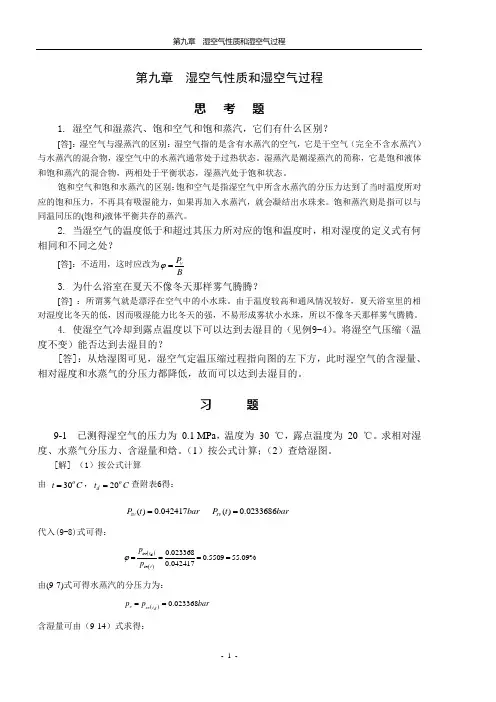
第九章 湿空气性质和湿空气过程思 考 题1. 湿空气和湿蒸汽、饱和空气和饱和蒸汽,它们有什么区别?[答]:湿空气与湿蒸汽的区别:湿空气指的是含有水蒸汽的空气,它是干空气(完全不含水蒸汽)与水蒸汽的混合物,湿空气中的水蒸汽通常处于过热状态。
湿蒸汽是潮湿蒸汽的简称,它是饱和液体和饱和蒸汽的混合物,两相处于平衡状态,湿蒸汽处于饱和状态。
饱和空气和饱和水蒸汽的区别:饱和空气是指湿空气中所含水蒸汽的分压力达到了当时温度所对应的饱和压力,不再具有吸湿能力,如果再加入水蒸汽,就会凝结出水珠来。
饱和蒸汽则是指可以与同温同压的(饱和)液体平衡共存的蒸汽。
2. 当湿空气的温度低于和超过其压力所对应的饱和温度时,相对湿度的定义式有何相同和不同之处?[答]:不适用,这时应改为v P Bϕ= 3. 为什么浴室在夏天不像冬天那样雾气腾腾?[答] :所谓雾气就是漂浮在空气中的小水珠。
由于温度较高和通风情况较好,夏天浴室里的相对湿度比冬天的低,因而吸湿能力比冬天的强,不易形成雾状小水珠,所以不像冬天那样雾气腾腾。
4. 使湿空气冷却到露点温度以下可以达到去湿目的(见例9-4)。
将湿空气压缩(温度不变)能否达到去湿目的?[答]:从焓湿图可见,湿空气定温压缩过程指向图的左下方,此时湿空气的含湿量、相对湿度和水蒸气的分压力都降低,故而可以达到去湿目的。
习 题9-1 已测得湿空气的压力为 0.1 MPa ,温度为 30 ℃,露点温度为 20 ℃。
求相对湿度、水蒸气分压力、含湿量和焓。
(1)按公式计算;(2)查焓湿图。
[解] (1)按公式计算由 30o t C =,20o d t C =查附表6得:()0.042417sv P t bar = ()0.0233686sv P t bar =代入(9-8)式可得:()()d sv sv 0.0233680.550955.09%0.042417t t p p ϕ==== 由(9-7)式可得水蒸汽的分压力为:()0.023368d v sv t p p bar ==含湿量可由(9-14)式求得:()0.55090.04241762262214.88/(?)-()1-0.55090.042417sr sr P t d g kg DA B P t ϕϕ⨯==⨯=⨯ 水蒸汽的焓可由(9-16)式求得:1.0050.001(2501 1.859)1.005300.00114.88(2501 1.85930)68.19/()H t d t kJ kg DA =++=⨯+⨯⨯+⨯=•(2)查 H-d 图(附录图Ⅲ)可得:55%ϕ=,()0.0233dv sv t p p bar ==,15/()d g kg DA =•,68/()H kJ kg DA =• 可见(1)、(2)两种方法求得参数是很吻合的。
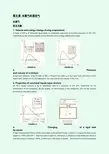
第五章 水蒸气和湿空气水蒸气 英文习题1. Volume and energy change during evaporationA mass of 200 g of saturated liquid water is completely vaporized at constant pressure of 100 kPa. Determine (a) the volume change and (b) the amount of energy added to the water.2.Pressureand volume of a mixtureA rigid tank contains 10 kg of water at 90℃. If 8 kg of the water is in the liquid form and rest is in thevapor form. Determine (a) the pressure in the tank and (b) the volume of the tank.3. Properties of saturated liquid-vapor mixtureAn 80-L vessel contains 4 kg of refrigerant-134a at a pressure of 160 kPa. Determine (a) the temperature of the refrigerant, (b) the quality, (c) the enthalpy of the refrigerant, and (d) the volume occupied by the vapor phase.4.Charging of a rigid tankby steamA rigid insulated tank that is initially evacuated is connected through a valve to a supply line that carries steam at 1 MPa and 300℃. Now the valve is opened, and steam is allowed to flow slowly into the tank until the pressure reaches 1 MPa, at which point the valve is closed.Determine the final temperatureFIGURE 5-1FIGURE 5-2FIGURE 5-3FIGURE 5-4of the steam in the tank.湿空气 英文习题1. The amount of water vapor in room air100 kPa A 5-m ×5-m×3-m room shown in Fig.5-1 contains air at 25℃ and at a relative humidity of 75 percent. Determine (a) the partial pressure of dry air, (b) the specific humidity, (c) the enthalpy per unit mass of the dry air,and (d) the masses of the dry air and water vapor in the room.2. Fogging of the windows in a houseIn cold weather, condensation frequently occurs on the inner surfaces of the windows due to the lower air temperatures near the window surface. Consider a house, shown in Fig.5-6, that contains air at 20℃ and 75 percent relative humidity. At what window temperature will themoisture in the air start condensing on the inner surfaces of thewindows?3. The specific and relative humidity of airThe dry and the wet-bulb temperatures of atmospheric air at 1 atm (101.325 kPa) pressure are measured with a sing psychrometer and determined to be 25℃ and 15℃, respectively. Determine (a0 the specific humidity, (b0 the relative humidity, and © the enthalpy of the air.4. Heating and humidification of airAn air-conditioning system is to take in outdoor air at 10℃ and 30 percent relative humidity at a steady rate of 45 m 3/min and to condition it to 25℃ and 60 percent relative humidity. The outdoor air is first then heated to 22℃ in the heating section and humidified by the injection of hot steam in the humidifying section. Assuming the entire process takes place at a pressure of 100 kPa, determine (a) the rate of heat supply in the heating section and (b) the mass flow rate of the steamrequired in the humidifying section.5. Cooling and dehumidification of airAir enters a window air conditioner at 1 atm, 30℃, and 80 percent relative humidity at rate of 10 m 2/min, and it leaves as saturated air at 14℃. Part of the moisture in the air that condenses during the process is also removed at 14℃. Determine the rates of heat and moisture removal from the air.工程热力学与传热学第五章 水蒸气与湿空气 习题FIGURE 5-5FIGURE 5-6FIGURE 5-7习题1.热水泵必须安装在热水容器下面距容器有一定高度的地方,而不能安装在热水容器的上面,为什么?2.锅炉产生的水蒸气在定温过程中是否满足q=w的关系?为什么?3.有无0℃或低于0℃的蒸汽存在?有无高于400℃的水存在,为什么?4.25MPa的水,是否也象1MPa的水那样经历汽化过程?为什么?5.dh=c p dT适用于任何工质的定压过程,水蒸气定压汽化过程中dT=0,由此得出结论,水定压汽化时dh=c p dT=0,此结论是否正确,为什么?6.试解释湿空气,湿蒸汽,饱和湿空气。
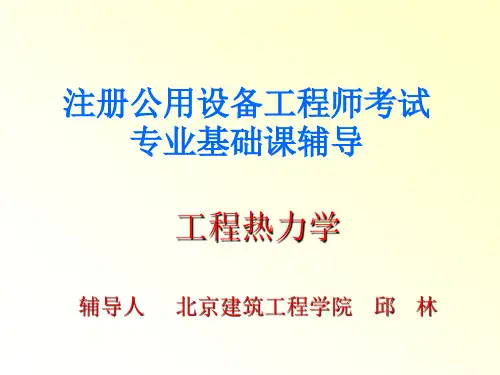
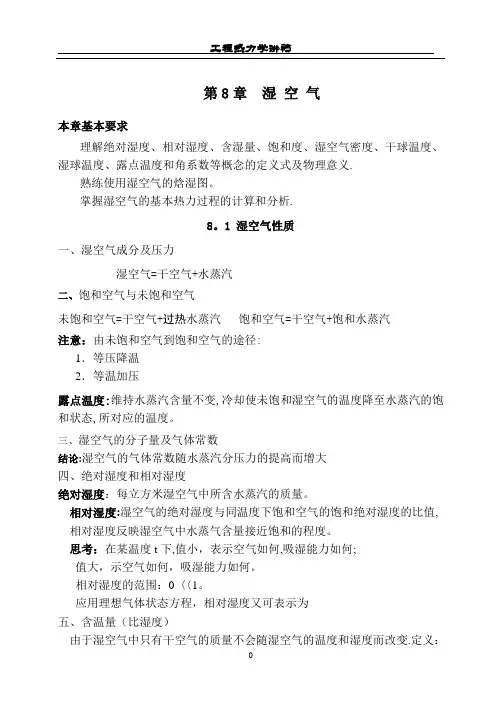
第8章湿空气本章基本要求理解绝对湿度、相对湿度、含湿量、饱和度、湿空气密度、干球温度、湿球温度、露点温度和角系数等概念的定义式及物理意义.熟练使用湿空气的焓湿图。
掌握湿空气的基本热力过程的计算和分析.8。
1 湿空气性质一、湿空气成分及压力湿空气=干空气+水蒸汽二、饱和空气与未饱和空气未饱和空气=干空气+过热水蒸汽饱和空气=干空气+饱和水蒸汽注意:由未饱和空气到饱和空气的途径:1.等压降温2.等温加压露点温度:维持水蒸汽含量不变,冷却使未饱和湿空气的温度降至水蒸汽的饱和状态,所对应的温度。
三、湿空气的分子量及气体常数结论:湿空气的气体常数随水蒸汽分压力的提高而增大四、绝对湿度和相对湿度绝对湿度:每立方米湿空气中所含水蒸汽的质量。
相对湿度:湿空气的绝对湿度与同温度下饱和空气的饱和绝对湿度的比值,相对湿度反映湿空气中水蒸气含量接近饱和的程度。
思考:在某温度t下,值小,表示空气如何,吸湿能力如何;值大,示空气如何,吸湿能力如何。
相对湿度的范围:0〈〈1。
应用理想气体状态方程,相对湿度又可表示为五、含温量(比湿度)由于湿空气中只有干空气的质量不会随湿空气的温度和湿度而改变.定义:含湿量(或称比湿度):在含有1kg干空气的湿空气中,所混有的水蒸气质量称为湿空气的).g/kg(a)六、焓定义:1kg干空气的焓和0。
001dkg水蒸汽的焓的总和代入:g/kg(a)七、湿球温度用湿纱布包裹温度计的水银头部,由于空气是未饱和空气,湿球纱布上的水分将蒸发,水分蒸发所需的热量来自两部分:1.降低湿布上水分本身的温度而放出热量.2.由于空气温度t高于湿纱布表面温度,通过对流换热空气将热量传给湿球。
当达到热湿平衡时,湿纱布上水分蒸发的热量全部来自空气的对流换热,纱布上水分温度不再降低,此时湿球温度计的读数就是湿球温度.湿球加湿过程中的热平衡关系式:由于湿纱布上水分蒸发的数量只有几克,而湿球温度计的读数又较低,在一般的通风空调工程中可以忽略不计。
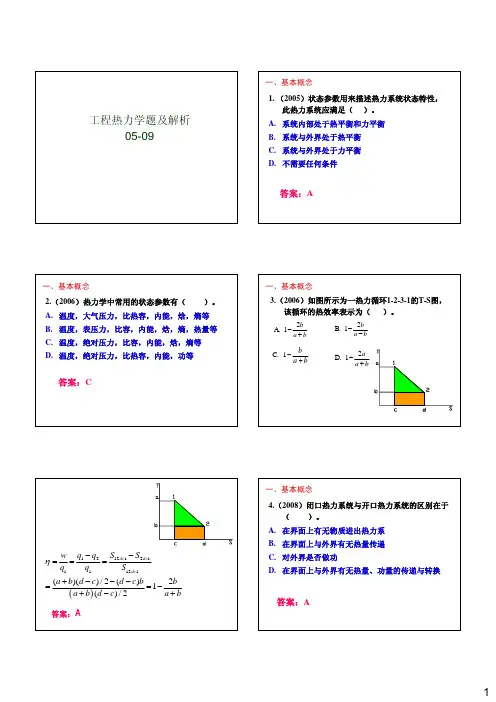
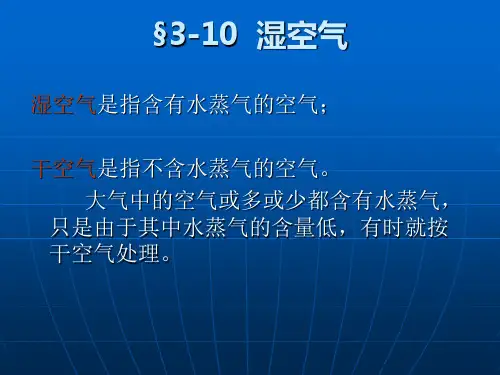
![(6)第五章水蒸汽热力性质_热工基础 [兼容模式].](https://uimg.taocdn.com/241e41e39ec3d5bbfd0a7444.webp)
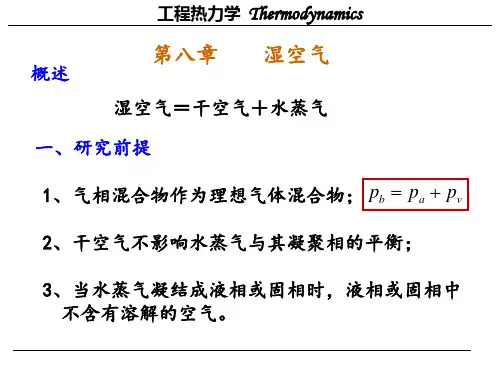
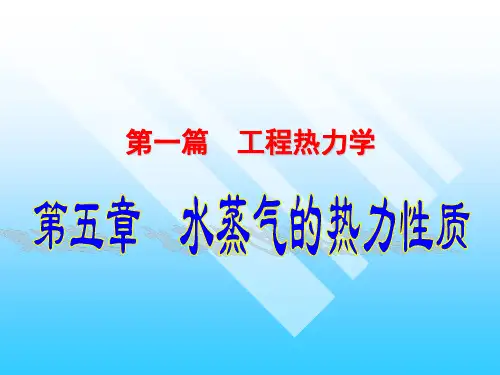
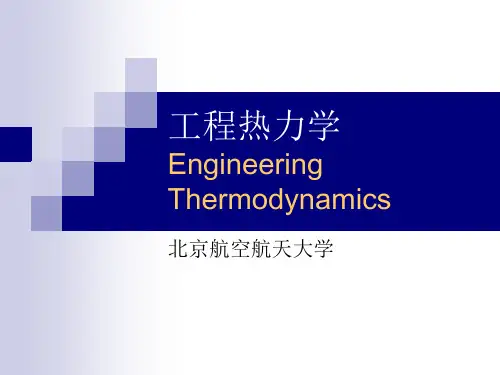
工程热力学知识点总结工程热力学知识点总结总结是指对某一阶段的工作、学习或思想中的经验或情况加以总结和概括的书面材料,它可以帮助我们总结以往思想,发扬成绩,为此要我们写一份总结。
你想知道总结怎么写吗?下面是小编帮大家整理的工程热力学知识点总结,欢迎大家分享。
第一章、基本概念1、边界边界有一个特点(可变性):可以是固定的、假想的、移动的、变形的。
2、六种系统(重要!)六种系统分别是:开(闭)口系统、绝热(非绝热)系统、孤立(非孤立)系统。
a.系统与外界通过边界:功交换、热交换和物质交换.b.闭口系统不一定绝热,但开口系统可以绝热。
c.系统的取法不同只影响解决问题的难易,不影响结果。
3、三参数方程a.P=B+Pgb.P=B-H这两个方程的使用,首先要判断表盘的压力读数是正压还是负压,即你所测物体内部的绝对压力与大气压的差是正是负。
正用1,负用2。
ps.《工程热力学(第六版)》书8页的系统,边界,外界有详细定义。
第二章、气体热力性质1、各种热力学物理量P:压强[单位Pa]v:比容(单位m^3/kg)R:气体常数(单位J/(kg*K))书25页T:温度(单位K)m:质量(单位kg)V:体积(单位m^3)M:物质的摩尔质量(单位mol)R:8.314kJ/(kmol*K),气体普实常数2、理想气体方程:Pv=RTPV=m*R。
*T/MQv=Cv*dTQp=Cp*dTCp-Cv=R另外求比热可以用直线差值法!第三章、热力学第一定律1、闭口系统:Q=W+△U微元:δq=δw+du (注:这个δ是过程量的微元符号)2、闭口绝热δw+du=03、闭口可逆δq=Pdv+du4、闭口等温δq=δw5、闭口可逆定容δq=du6、理想气体的热力学能公式dU=Cv*dT一切过程都适用。
为什么呢?因为U是个状态量,只与始末状态有关、与过程无关。
U是与T相关的单值函数,实际气体只有定容才可以用6、开口系统ps.公式在书46页(3-12)7、推动功Wf=P2V2-P1V1(算是一个分子流动所需要的微观的能量)a、推动功不是一个过程量,而是一个仅取决于进出口状态的状态量。